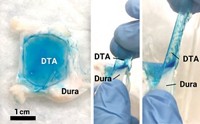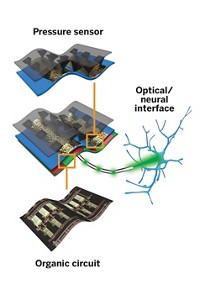Advertisement
Grab your lab coat. Let's get started
Welcome!
Welcome!
Create an account below to get 6 C&EN articles per month, receive newsletters and more - all free.
It seems this is your first time logging in online. Please enter the following information to continue.
As an ACS member you automatically get access to this site. All we need is few more details to create your reading experience.
Not you? Sign in with a different account.
Not you? Sign in with a different account.
ERROR 1
ERROR 1
ERROR 2
ERROR 2
ERROR 2
ERROR 2
ERROR 2
Password and Confirm password must match.
If you have an ACS member number, please enter it here so we can link this account to your membership. (optional)
ERROR 2
ACS values your privacy. By submitting your information, you are gaining access to C&EN and subscribing to our weekly newsletter. We use the information you provide to make your reading experience better, and we will never sell your data to third party members.
Materials
Silken Electronics
Biomaterials: Electrode arrays constructed from films of silk cling to the brain
by Bethany Halford
April 26, 2010
| A version of this story appeared in
Volume 88, Issue 17

By building electronics on substrates of silk, scientists have created devices so thin and flexible that they hug the brain’s ridges and grooves (Nat. Mater., DOI: 10.1038/nmat2745). The technology could improve the interface between the brain and electronic devices, according to its creators, and could lead to novel diagnostics and therapies.
“We were trying to develop a new strategy for intimately and noninvasively integrating electronics with the human brain,” says John A. Rogers, a University of Illinois, Urbana-Champaign, chemistry professor who spearheaded the work along with University of Pennsylvania bioengineering professor Brian Litt. To that end, the researchers created ultrathin electrode arrays with an open-mesh design made from conventional materials.
On their own, however, these netlike arrays were simply too floppy to mount onto the bumps and ridges of the brain. The team reasoned that constructing the arrays on a soluble substrate that is both thin and flexible would provide the support they were looking for and would eventually dissolve away.
Silk turned out to be the ideal material, Rogers explains, because it’s water-soluble, forms smooth films, and is biocompatible (silk sutures have been approved by the Food & Drug Administration). When the silk dissolves, it leaves behind an electronic mesh that gently shrink-wraps the brain tissue.
“The result is a high-quality interface with the capability for measuring electrical activity in the brain with unmatched precision in a manner that does not damage the tissue in any way,” Rogers says. “The potential applications range from systems for diagnosing and treating epilepsy to devices for brain-machine interfaces for controlling prosthetics,” he adds.
It’s a “very clever but simple approach,” says William M. Reichert, a professor of biomedical engineering at Duke University. “This is a very interesting technology because it addresses two critical issues: intimate contact with nonuniform and hydrated tissues, and it avoids the trauma of puncture wounds.”





Join the conversation
Contact the reporter
Submit a Letter to the Editor for publication
Engage with us on Twitter